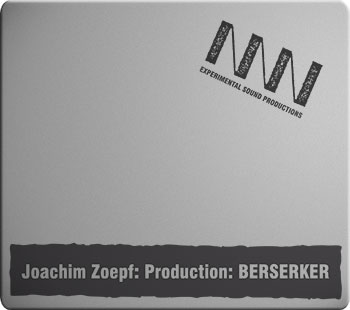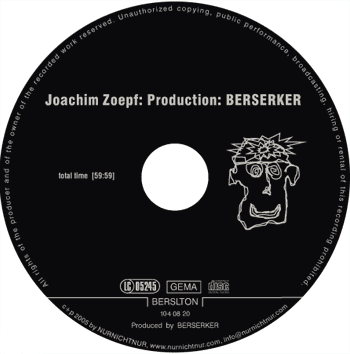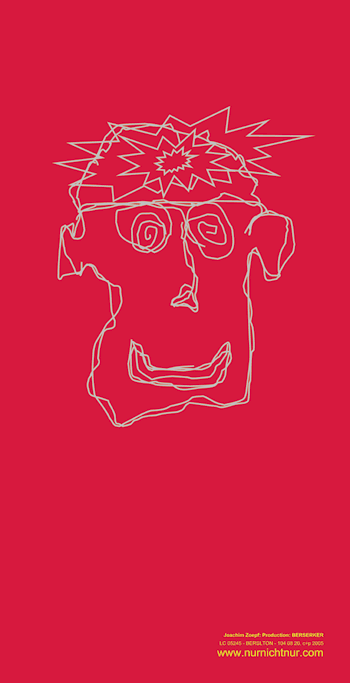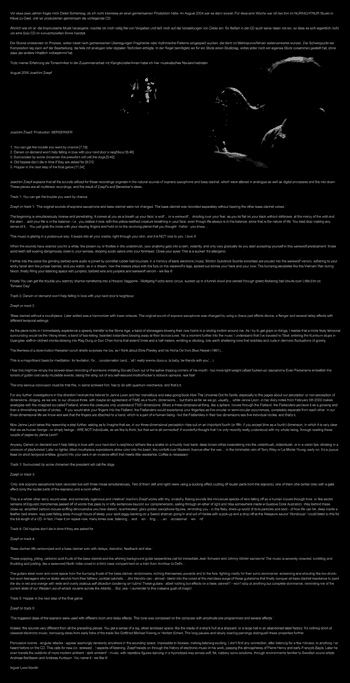
Joachim Zoepf: Production: BERSERKER
1. You can get the trouble you want by chance [7:19]
2. Darwin on demand won't help falling in love with your next door's neighbour [6:46]
3. Surrounded by some chinamen the president will call the dogs [5:42]
4. Old hippies don't die in time if they are asked for [9:01]
5. Hopper in the next step of the final game [11:54]
Total time [59:59]



funky hell, das rockt!!
und wie seit den monks nicht mehr!!
dazwischen chinesen und des präsidenten hunde [track 3]... sehr delikat!!! der ungelistete track 6 beinhaltet dann auch noch [nach über 12 min.!!!] einen 'hidden track'... sehr dada!!!
und schwups, haste nich gesehn, das beste, was ich seit ich weiß nicht mehr in meinem cd-spieler hatte.
wow!!
Marcus Heesch: Gruß vom Mars, 07.11.2005
Effektiver als der etwas gewagte Humor zupfen die Aliensounds an Zwerch- und Trommelfell. Der perkussive Gummigroove von ‚Hopper...‘ kommt von ganz weit draußen, beim hippieziden 4. Track overkillt ‚Gitarren‘-Gejaule ein ‚Didgeridoo‘-Duett. Davor gab es nur spitzes Gezüngel und hechelndes Gezischel, Luft und Spucke im kitzligen Sopranissimo (‚Surrounded by some chinamen...‘), hingestöhntes Nebelhorngetute und ursuppiges Bassgeschnarre, gespickt mit Sopranosplittern (‚Darwin on demand...‘) und gleich zum Auftakt einen Funkenflug zwischen den hufeisenförmig kurz geschlossenen Enden des Klangspektrums, fiepig diskante Sopranospitzen und dickes Bassklarinettengetröpfel, das zum pummeligen Hummelangriff sich verdichtet. Eindeutig eine Produktion mit Tu-nicht-so-erwachsen-Appeal.
Rigobert Dittmann, Bad Alchemy 49
Aided by the electronic wizardry of Berserker’s production – both pre-and-post – and using
delays, distortion, double tracking and feedback, his bass clarinet and soprano saxophone textures combine, divide and
contort throughout. The overall effect is as if the members of a woodwind or saxophone combo were recorded as they receive
electro convulsive therapy.
To get particular, Planques is more-or-less a recital, with its seven linked tracks evolving from staccato air expelled
through the saxophone’s body tube to showcasing expansive undulating note formations, lip squeaks and overblowing.
Here wave forms sequentially dissolve and solidify, making the vibrating tinctures of color audible as well as the initially
tongued note, and often exposing two distinct tones.
Regularly multi-tracked and distorted, Zoepf’s
two horns on Production: Berserker utilize more of these aural comparisons – often reaching the status of non-reed
instruments. Along with the saxophonist’s triple-tongued flutters and swarming buzzing trills is processing that
causes chords to resonate wind-tunnel-like as if they come from a church organ. Bass clarinet played without a mouthpiece
can sound like col legno string techniques, while flanged, tremolo soprano saxophone distortions take on jew’s
harp-like twanging. Elsewhere overblown feedback pulled from a brace of bass clarinets is altered and converted into
psychedelic-era electric guitar riffs.
Indefinite sustain that could result from using an e-bow on guitar strings also makes an appearance as well. But perhaps
that shouldn’t be a surprise, since in the past the saxophonist, has collaborated with players like Hans Tammen,
who specialize in similar guitar experimentation. Zoepf is evidentially interested in exposing exceptional or universal
properties, not ones directly related to metal, reeds, ligature or keys.
Tracks are sometimes pointillist, assembled in dribs and dabs from understated intermezzo expansions, or more spectacularly
stitched together from glottal stopping, hocketing, subdivided chirping or the use of several mics to amplify fingernail
scratches to percussion. Delay and modulation allow reed tones – computer generated or not – to reflect back
onto themselves, while the nearly 20-minute final “hidden” track is constructed from strident wave-form distortions,
a centerpiece of pure silence – at least to the human ear – and a cumulative postlude that shrills ever noisier
reed tones.
With such bravura performances, the CD suggests that its proper appreciation of comes from listening to individual
tracks, rather than trying the entire CD at one sitting.
Ken Waxman at JazzWeekly